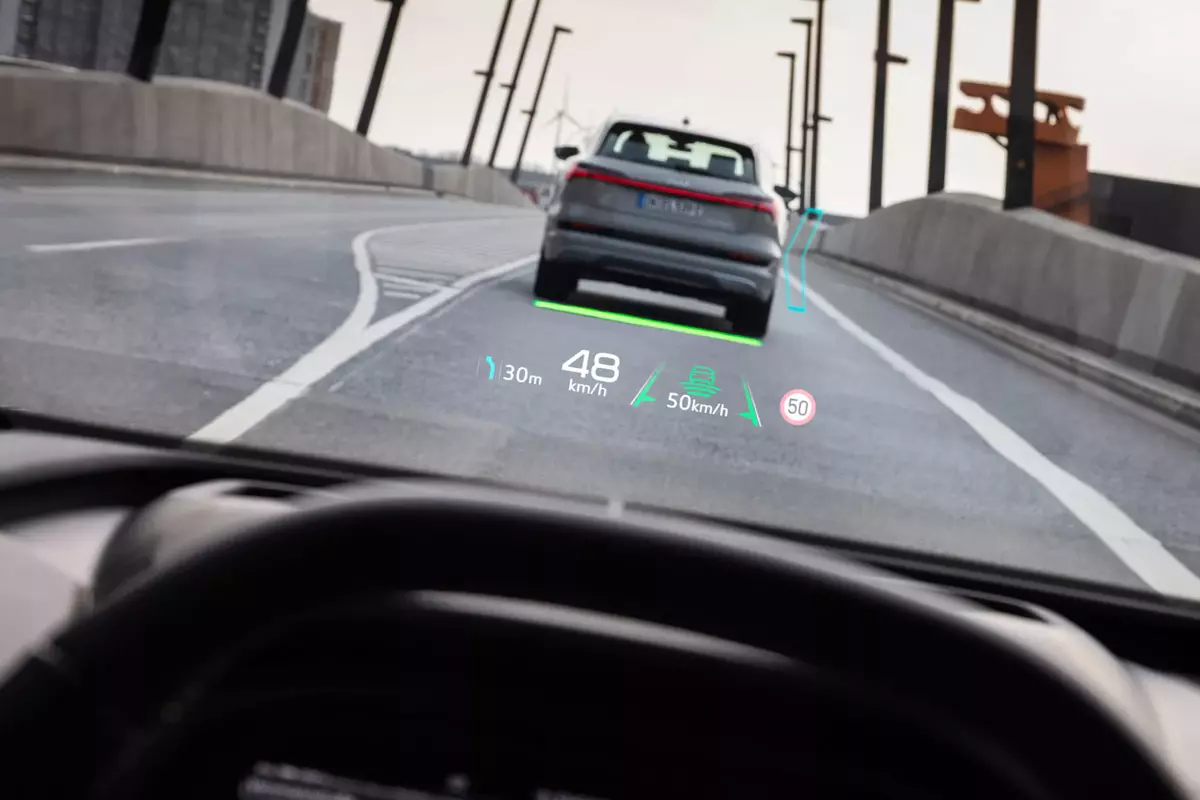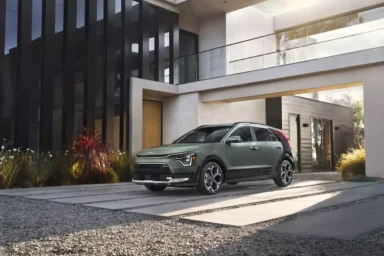Heads-up display (HUD) technology is revolutionizing how we drive by projecting crucial information onto the windshield or a combiner screen directly in the driver’s line of sight.
Originating in the aviation industry, HUDs have entered the automotive world, providing drivers a safer and more convenient experience.
The primary purpose of HUDs is to allow drivers to access important information without taking their eyes off the road. This not only enhances safety but also improves overall driving comfort.
In this article, I will cover everything about heads-up displays. But first, I will provide a list of available cars with HUDs.
So, Let’s get into it!
Table of Contents
List of Cars with Heads-Up Display
Here is a list of cars available with HUDs. However, remember that HUD is currently an expensive feature, so in some models, you need to opt for a higher trim level to get it. Additionally, some models offer it only as an optional feature.
| Brand | Model |
|---|---|
| Acura | Acura Integra Acura MDX Acura RDX Acura TLX |
| Audi | Audi Q4 e-tron Audi Q4 Sportback e-tron Audi e-tron Audi e-tron GT Audi Q3 Audi Q5 Audi Q6 Audi Q8 Audi A3 Audi A4 Audi A5 Audi A6 Audi A7 Audi A8 |
| BMW | BMW 2 Series BMW 3 Series BMW 4 Series BMW 5 Series BMW 7 Series BMW 8 Series BMW i4 BMW i7 BMW iX BMW X1 BMW X2 BMW X3 BMW X4 BMW X5 BMW X6 BMW X7 BMW Z4 |
| Bentley | Bentley Bentayga Bentley Continental GT Bentley Flying Spur |
| Buick | Buick Enclave Buick Encore GX Buick Envision |
| Cadillac | Cadillac CT4 Cadillac CT5 Cadillac Escalade Cadillac Lyriq Cadillac XT4 Cadillac XT5 Cadillac XT6 |
| Chevrolet | Chevrolet Camaro Chevrolet Corvette Chevrolet Silverado 1500 Chevrolet Silverado 2500/3500 Chevrolet Suburban Chevrolet Tahoe |
| Ford | Ford Mustang Shelby Ford Escape |
| Genesis | Genesis G70 Genesis G80 Genesis G90 Genesis GV70 Genesis GV60 Genesis GV80 |
| GMC | GMC Acadia GMC Sierra 1500 GMC Sierra 2500/3500 GMC Terrain GMC Yukon |
| Hyundai | Hyundai Ioniq 5 Hyundai Palisade Hyundai Santa Fe Hyundai Sonata |
| Infiniti | Infiniti QX50 Infiniti QX55 Infiniti QX60 |
| Jaguar | Jaguar E-Pace Jaguar F-Pace Jaguar I-Pace Jaguar XF |
| Jeep | Jeep Grand Cherokee Jeep Wagoneer Jeep Grand Wagoneer |
| KIA | Kia EV6 Kia Seltos Kia Soul Kia Stinger Kia Telluride |
| Land Rover | Land Rover Defender Land Rover Discovery Land Rover Discovery Sport Land Rover Range Rover Land Rover Range Rover Evoque Land Rover Range Rover Sport Land Rover Range Rover Velar |
| Lexus | Lexus ES Lexus LC Lexus LS Lexus LX Lexus NX Lexus RX Lexus UX |
| Lincoln | Lincoln Aviator Lincoln Corsair Lincoln Navigator |
| Mazda | Mazda CX-30 Mazda CX-5 Mazda CX-50 Mazda CX-9 Mazda CX-90 Mazda Mazda3 |
| Mercedes-Benz | Mercedes-Benz A-Class Mercedes-Benz C-Class Mercedes-Benz CLA Mercedes-Benz CLS Mercedes-Benz E-Class Mercedes-Benz GLA Mercedes-Benz GLB Mercedes-Benz GLC Mercedes-Benz GLE Mercedes-Benz GLS Mercedes-Benz S-Class Mercedes-Benz EQS Mercedes-Benz AMG GT Mercedes-Benz AMG SL |
| Mini | Mini Hardtop Mini Clubman Mini Convertible Mini Countryman |
| Nissan | Nissan Ariya Nissan Murano Nissan Rogue Nissan Pathfinder |
| Porsche | Porsche Panamera Porsche Cayenne Porsche Taycan |
| Rolls-Royce | Rolls-Royce Cullinan Rolls-Royce Ghost Rolls-Royce Phantom |
| Subaru | Subaru Ascent Subaru BRZ Subaru Legacy Subaru Outback Subaru WRX |
| Toyota | Toyota Avalon Toyota Camry Toyota Highlander Toyota Mirai Toyota Prius Toyota RAV4 Prime Toyota Sienna Toyota Supra Toyota Sequoia Toyota Tundra Toyota Venza |
| Volvo | Volvo EX90 Volvo S60 Volvo S90 Volvo V60 Volvo V90 Cross Country Volvo XC60 Volvo XC90 |
In addition to the list above, several other popular cars feature heads-up displays, including the Honda Accord, RAM 1500, Mitsubishi Outlander, and Lamborghini Urus.
Advantages of Heads-Up Displays in Cars
The Heads-Up Displays feature has several benefits, including:
Improved Driver Safety
HUDs significantly contribute to driver safety by keeping vital information within the driver’s line of sight.
By projecting information such as speed, navigation directions, and warning indicators directly onto the windshield or a combiner, drivers can maintain their focus on the road, reducing the risk of accidents due to distractions.
Enhanced Driver Focus and Situational Awareness
Heads-up displays help enhance driver focus and situational awareness by minimizing the need to look away from the road.
With crucial data readily available in their field of vision, drivers can effortlessly process information and make better decisions on the road, especially during complex driving situations such as merging onto highways or navigating through busy intersections.
Convenience and personalization
Modern HUDs offer customizable options, allowing drivers to choose which information is displayed and how it is presented.
This personalization ensures that drivers have access to the data most relevant to their needs, enhancing their overall driving experience.
Additionally, many HUDs can integrate with smartphones, enabling the display of incoming calls, messages, and other notifications, providing further convenience.
Futuristic Driving Experience
Beyond their practical benefits, HUDs also contribute to a more futuristic driving experience by incorporating cutting-edge technology into the vehicle’s design.
A HUD’s sleek, modern appearance adds a touch of sophistication to any car’s interior, making the driving experience feel more advanced and engaging.
Types of Heads-Up Display Systems
Windshield-projected HUDs
Windshield-projected HUDs are directly integrated into a car’s design and project information onto the windshield.
This type of HUD offers a seamless experience, as the data appears floating in the driver’s line of sight.

Windshield-projected HUDs are typically found in high-end and luxury vehicles but are becoming more common in mid-range models.
Combiner-projected HUDs
Combiner-projected HUDs utilize a separate transparent screen, or combiner, placed between the driver and the windshield to display information.
This type of HUD is a popular choice for cars that do not have windshield-projected systems, as it can be easily retrofitted without significant modifications.
Combiner-projected HUDs are more affordable than windshield-projected systems, but they may offer a different level of integration and aesthetic appeal.
Aftermarket HUDs
Aftermarket HUDs are add-on devices that can be installed in vehicles without built-in HUD systems.
They are available in windshield-projected and combiner-projected varieties and can be connected to a car’s diagnostic system to display relevant information.
Aftermarket HUDs vary in terms of features, compatibility, and quality, offering drivers a wide range of options to choose from.
Augmented reality (AR) HUDs
Augmented reality HUDs represent the cutting edge of heads-up display technology.
These systems integrate real-time data with the vehicle’s surroundings, overlaying information such as navigation instructions, points of interest, and traffic alerts onto the driver’s view of the road.
While AR HUDs are still relatively new, they are expected to become more common as technology advances and becomes more affordable.
Can You Add an OEM Heads Up Display to a Car?
If your car doesn’t have a HUD feature, you can still add one by purchasing an aftermarket unit.
Aftermarket HUDs come in various forms, including windshield-projected and combiner-projected options.
Some aftermarket HUDs plug directly into a car’s OBD-II port, providing access to vehicle data such as speed, fuel consumption, and engine diagnostics. Others rely on smartphone connectivity to display information like GPS navigation and notifications.
Several brands offer high-quality aftermarket HUDs with various features to suit different needs and preferences. Some popular brands and models include:
- Navdy
- Garmin HUD+
- Hudway Cast
- Exploride
- Carrobot C2 Lite
Factors to consider when choosing an aftermarket HUD
When selecting an aftermarket HUD, consider the following factors:
- Display quality: Ensure the HUD offers clear and bright visuals, even in direct sunlight or at night.
- Compatibility: Verify that the HUD is compatible with your car’s make, model, and diagnostic system.
- Ease of installation: Opt for a HUD with a straightforward installation process that requires minimal modifications to your vehicle.
- Customizability: Choose a HUD that allows you to customize the displayed information and interface to suit your preferences.
- Smartphone integration: If desired, look for a HUD that can connect to your smartphone for additional functionality.
How Much Does It Cost to Add HUD to Car?
The cost of adding a HUD to your car depends on the type of aftermarket heads-up display system you choose and whether you opt for professional installation. Here’s a general breakdown of the costs:
- Basic aftermarket HUDs: These typically cost between $50 and $200. They may have limited features and connectivity but can still display essential information such as speed and engine diagnostics.
- Mid-range aftermarket HUDs: These devices usually range from $200 to $500, offering better display quality, customizability, and smartphone integration.
- High-end aftermarket HUDs: Advanced HUDs with features like augmented reality, enhanced connectivity, and superior display quality can cost upwards of $500 to $1,000 or more.
- Professional installation: If you choose to have your HUD professionally installed, you may need to factor in additional labor costs, which can range from $50 to $200, depending on the complexity of the installation and the rates of the installer.
Remember that prices may vary based on the brand, specific model, and features of the aftermarket HUD you choose. Researching and comparing different options is essential to find a heads-up display system that meets your needs and budget.
Future Trends in HUD Technology
Integration with Autonomous Driving Systems
As autonomous driving technology advances, HUDs are expected to provide drivers with real-time information about their vehicle’s status and surroundings. The seamless integration of HUDs with self-driving systems could enable drivers to monitor the vehicle’s performance, receive important alerts, and effortlessly switch between autonomous and manual modes, enhancing overall safety and convenience.
Advanced AR Features and Holography
Augmented reality (AR) HUDs are poised to become more sophisticated, with advanced features such as holography and integration with LiDAR sensors for improved depth perception.
This could allow for more accurate information overlays onto the driver’s view of the road, enhancing situational awareness and creating a more immersive driving experience.
Gesture and Voice Command
Future HUDs may incorporate gesture and voice control features, enabling drivers to interact with the display and access information without taking their hands off the wheel or their eyes off the road.
This hands-free interaction could streamline the driving experience and further minimize distractions.
HUD will be Available in Lower-priced Car Models
As HUD technology becomes more affordable and mainstream, it will likely be adopted by a broader range of car models, including lower-priced vehicles.
This increased accessibility will enable more drivers to enjoy the benefits of heads-up displays, contributing to safer and more enjoyable driving experiences.
Conclusion
In summary, HUDs significantly enhance driver safety, focus, and convenience by projecting essential information within the driver’s line of sight.
With advancements in technology and the growing adoption of HUDs across various car models, the future of driving promises to be safer and more engaging.
As HUD technology evolves, it’s an excellent time to explore and consider incorporating this valuable feature into your driving experience.


